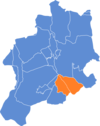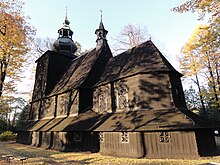Mikuszowice
| Mikuszowice | ||
|---|---|---|
 Help on coat of arms |
|
|
| Basic data | ||
| State : | Poland | |
| Voivodeship : | Silesia | |
| Powiat : | Bielsko-Biała | |
| Gmina : | Bielsko-Biała | |
| Area : | 16.3 km² | |
| Geographic location : | 49 ° 47 ' N , 19 ° 4' E | |
| Residents : | 10,041 (2006-12-31) | |
| Telephone code : | (+48) 33 | |
| License plate : | SB | |
Mikuszowice (formerly Mikłuszowice ; German Nikelsdorf ), actually Mikuszowice Śląskie (formerly also Mikuszowice Niemieckie ) and Mikuszowice Krakowskie (formerly also Mikuszowice Polskie ) are two districts ( Osiedla ) of Bielsko-Biała in the Silesian Voivodeship in Poland .
geography
Mikuszowice is on the border of the Silesian Foothills in the north, the Silesian Beskids in the southwest and the Little Beskids in the southeast, on the Biała (Bialka) , about 4 km south of the city center.
In 1910 Mikuszowice Śląskie (excluding Olszówka Dolna ) had an area of 276 ha and Mikuszowice Krakowskie of 345 ha, together: 621. Today's districts have 1247.13 ha (Mikuszowice Śląskie with the largest part of Olszówka) and 386.02 ha (Krakowskie), total: 1633.15 ha.
history
The former village was built in the late 13th or early 14th century in the course of the colonization under German law under Duke Mieszko von Teschen-Auschwitz on both banks of the river Biała (Bialka). The first documented mentions of the village of villa Nikolai come from the turn of the 13th to 14th century (an early modern copy of Mieszko's I document without date). This was followed by the German name Nickelstorff (an early modern German-language copy of a Latin document from 1312) and Nicklosdorff (German-language document from 1413). The Polish patronymic name appeared in 1457 as Mykluschowicze . It has long been thought that the village was founded by a certain German named Nickels or Nikles , but the last find of the oldest form villa Nikolai points to Mikołaj (German Nikolaus ). The first known Polish place name, however, was derived from the form of the personal name Mikłusz (≤ Mikołaj ) with the typical West Slavic word ending - (ow) ice.
Politically, the village originally belonged to the Duchy of Teschen , which existed from 1290 during the period of Polish particularism . In 1315 the Duchy of Teschen was divided along the river Biała and the village was also divided: the part on the left bank remained in the Duchy of Teschen, the part on the right bank came to the Duchy of Auschwitz . Since 1327 both were under the feudal rule of the Kingdom of Bohemia .
Mikuszowice Krakowskie
The Duchy of Auschwitz with the village of Mykluschowicze was bought by the Polish king in 1457. In 1564, the Duchy of Auschwitz-Zator was annexed to the Kingdom of Poland as the Silesia District of the Krakow Voivodeship .
The church, built in 1455 in the late 16th century, became the seat of a Lutheran congregation. In 1615 Piotr Warszycki, the owner of Łodygowice , gave the church back to Catholics. In 1687 the church was burned, three years later the St. Barbara Church (wooden church) was rebuilt.
During the first partition of Poland in 1772 the village became part of the new Kingdom of Galicia and Lodomeria of the Habsburg Empire (from 1804). In the 19th century the number of inhabitants increased in Bielitz and Biała due to industrialization .
In 1900 the village had 1060 inhabitants, mostly Polish-speaking and Roman-Catholic (84 were German-speaking, 5 were Israelite, 57 of other faiths).
In 1918, after the end of the First World War and the collapse of the Austro-Hungarian monarchy, it became part of Poland.
Mikuszowice Śląskie
The village in the Duchy of Teschen had belonged to the Habsburg monarchy since 1526 . Since 1572 it belonged to the dominion of Bielitz (from 1754 Duchy of Bielitz ).
It was later mentioned again with a German name: Nickelsdorf / Nicklosdorff (1413), Polish mezy wsy Miklussowiczemi, appeared in 1547 (a century later than in the case of Mikuszowice Krakowskie).
After the abolition of patrimonial it formed from 1850 a municipality together with Olszówka Dolna ( Nieder Ohlisch ) in Austrian Silesia , district and judicial district Bielitz . In the years 1880–1910, the population of the municipality increased from 809 in 1880 to 1502 in 1910; the majority were German-speaking (between 79.4% and 83.6%), but also Polish-speaking (between 13.7% and 20 , 4%). In 1910 59.8% were Roman Catholic, 35% Protestant, 75 (5%) Jews, 3 of other faiths. It belonged to the Bielitz-Biala language island .
In the late 19th century, Mikuszowice Śląskie became a health resort for residents of Bielsko.
In 1920, after the collapse of the Austro-Hungarian monarchy and the end of the Polish-Czechoslovak border war , Poland became part of it. This was only interrupted by the occupation of Poland by the Wehrmacht in World War II .
After the First World War
Before 1954, Mikuszowice Krakowskie belonged to the rural municipality of Biała Wieś , since 1955 an independent Gromada. Mikuszowice Śląskie became a municipality in 1945, since 1946 collective municipality, since 1955 Gromada, since 1958 a town-like settlement. Both Mikuszowce were incorporated into the town of Biała-Biała in 1969.
Web links
- Mikuszowice . In: Filip Sulimierski, Władysław Walewski (eds.): Słownik geograficzny Królestwa Polskiego i innych krajów słowiańskich . tape 6 : Malczyce – Netreba . Walewskiego, Warsaw 1885, p. 415 (Polish, edu.pl ).
Individual evidence
- ↑ a b c Rada Miejska w Bielsku-Białej: Program rewitalizacji obszarów miejskich w Bielsku-Białej na lata 2007–2013. (PDF) December 7, 2007, pp. 9–10 , accessed on May 21, 2015 (Polish).
- ↑ a b c d e Robert Mrózek: Nazwy miejscowe dawnego Śląska Cieszyńskiego . Uniwersytet Śląski w Katowicach , 1984, ISSN 0208-6336 , p. 117 (Polish).
- ↑ Marcin Żerański: Śląsk Bielski (Silesia) or Bielsko-Białej do Ostrawy. Przewodnik turystyczny . Pracownia na Pastwiskach, Bielsko-Biała 2012, ISBN 978-83-933109-3-7 , p. 264 (Polish).
- ↑ a b Ludwig Patryn (ed): The results of the census of December 31, 1910 in Silesia , Opava 1912.
- ↑ a b Ludwig Patryn (ed): Community encyclopedia of the kingdoms and countries represented in the Imperial Council, edited on the basis of the results of the census of December 31, 1900, XII. Galicia , Vienna 1907.
- ↑ a b Przemysław Stanko: Monografia Gminy Wilkowice . Wydawnictwo Prasa Beskidzkia, Wilkowice 2014, ISBN 978-83-940833-0-4 , p. 77 (Polish).
- ^ Krzysztof Rafał Prokop: Księstwa oświęcimskie i zatorskie wobec Korony Polskiej w latach 1438-1513. Dzieje polityczne . PAU , Kraków 2002, ISBN 83-8885731-2 , p. 151 (Polish).
- ^ Idzi Panic: Śląsk Cieszyński w początkach czasów nowożytnych (1528-1653) . Starostwo Powiatowe w Cieszynie, Cieszyn 2011, ISBN 978-83-926929-5-9 , p. 226 (Polish).
- ↑ Kazimierz Piątkowski: Stosunki narodowościowe w Księstwie Cieszyńskiem . Macierz Szkolna Księstwa Cieszyńskiego, Bielsko-Biała 1918, p. 257, 276 (Polish, opole.pl ).
- ↑ hałcnowski i bielsko-bialska wyspa językowa. Dziedzictwo językowe Rzeczypospolitej, 2014, accessed October 12, 2014 (Polish).
- ^ Idzi Panic (editor): Bielsko-Biała. Monografia miasta . 2nd Edition. IV. Bielsko-Biała w latach 1918–2009. Wydział Kultury i Sztuki Urzędu Miejskiego w Bielsku-Białej, Bielsko-Biała 2011, ISBN 978-83-60136-26-3 , Bielsko-Biała w Polsce Ludowej 1945–1990. Administracja i samorząd miejski, p. 408-409 (Polish).




